The Vault is Slate’s history blog. Like us on Facebook, follow us on Twitter @slatevault, and find us on Tumblr. Find out more about what this space is all about here.
This 1903 map of “Race and Occupation of Immigrants by Destination” crowds information about national origin, occupations, and state-level longitudinal trends in immigration into a busy geography of the United States.
A reader could use the map to see which proportion of the immigrant population of a state came from each of six “races or peoples”: “Teutonic,” “Keltic,” “Slavic,” “Iberic,” “Mongolic,” or Other. These designations echoed popular eugenic racial ideologies of the time, which used quasi-scientific theories to lump people into basic groups of origin understood to share common characteristics. The bars showing percentages of immigrants in each state color-code the newcomers according to “race or people,” so that these can be seen at a glance, then use text to explain which countries these “Mongolians” or “Slavics” came from.
The map was put together as part of an annual report made for the Commissioner-General of Immigration, and printed by the Government Printing Office in 1903. The somewhat clumsy infographic follows more graceful Census Department charts and maps made in the second half of the 19th century, and shows how government agencies experimented with information display as they put greater emphasis on the collection and use of data.
Click on the image below to reach a zoomable version. I first saw this map on John Ptak’s Ptak Science Books blog.

Michigan State University Digital Library.